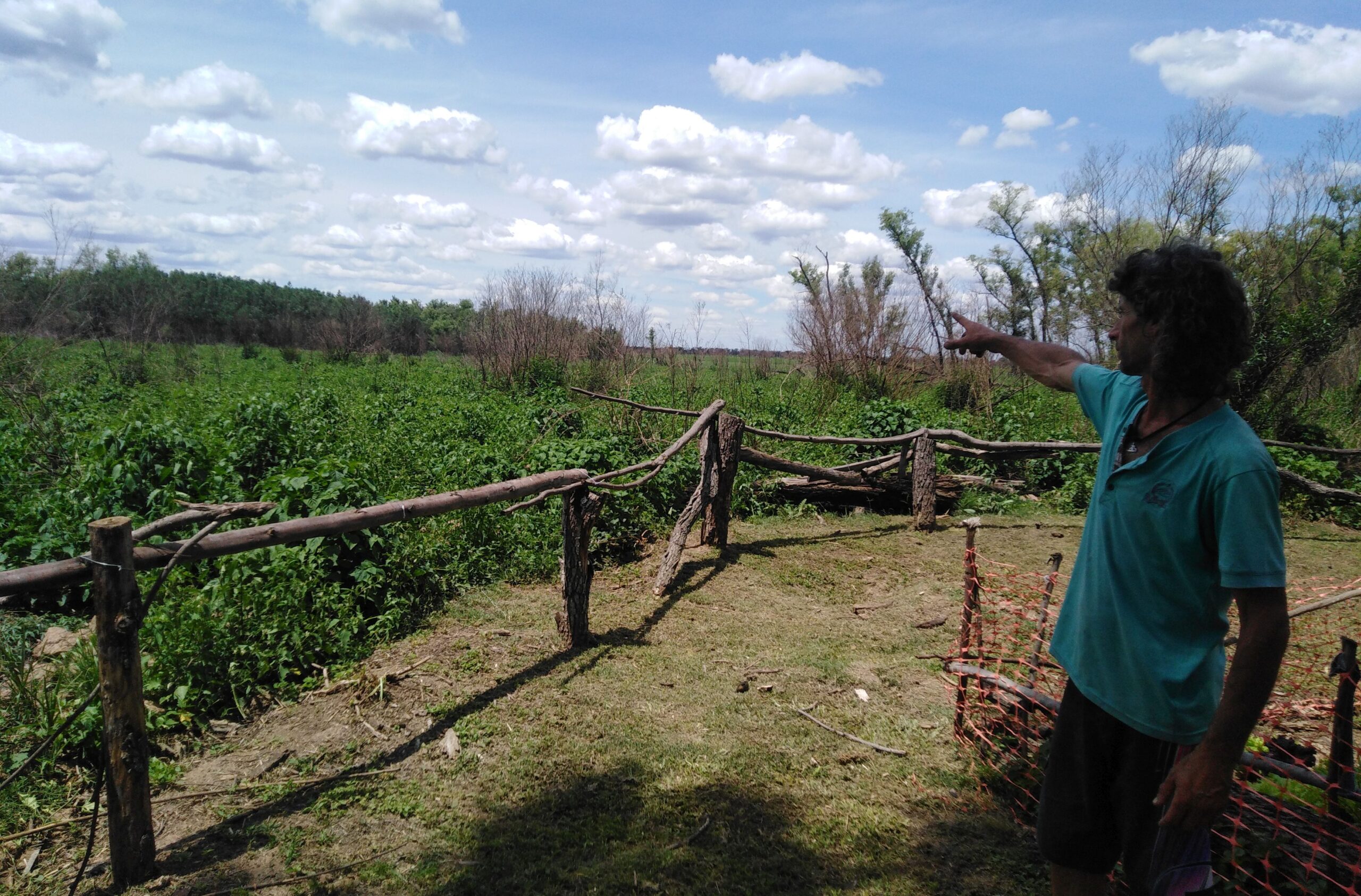
Fuego en Argentina: incendios en el delta del Paraná son amenaza para la vida
Read the story in English here.
El domingo, 23 de agosto, alrededor de las 3 p.m., el fuego llegó a la casa de Fabián Ros, 53. Hasta ese día, él y su esposa, Viviana, habían visto varios incendios y columnas de humo a varios kilómetros de su casa, una cabaña en la isla La Deseada –una de las miles que conforma el delta del río Paraná. Pero ese día, finalmente, el fuego tocaba su puerta.
Una laguna situada 500 metros al este de su cabaña, seca por la sequía histórica que azota al Paraná este año, sirvió como un canal para el avance de los incendios más alejados. “La laguna era un mar de paja y ramas secas: era dinamita”, recuerda Fabián.
No estaban solos. Horas antes habían alertado sobre la situación a sus hijos, que viven en Rosario –la ciudad que se ubica justo en frente de su isla–, y a otros vecinos isleños de la zona y voluntarios. Entre todos, empezaron a improvisar acciones para impedir el avance del fuego, que se acercaba cada vez más.
En medio de la emergencia, llegaron dos brigadistas del Servicio Nacional de Manejo del Fuego y un vecino más, también experto en incendios. Eso tranquilizó a Fabián. Por fin, gente con una mejor estrategia. Ellos les dijeron al resto que había que cercar el paso del fuego. Pararlo era imposible, pero podían desviarlo. Podían montar un cortafuego que le impidiera avanzar hacia la casa.
El fuego llegaba por dos flancos: norte y este. Las llamas del norte avanzaban con más velocidad. El plan era cercar su paso, creando un perímetro de 10 metros alrededor de la casa y apagando el fuego con todo lo disponible. Empezaron. Usaron grandes cantidades de agua, pero también sierras y machetes para deshacer las ramas y troncos secos que podrían permitir el avance del fuego. Lo lograron. Pero a los pocos minutos, el fuego se encontró con el flanco este. Chocaron. “Ahí se vino todo, se prendieron las copas de los árboles. Pero no avanzó por abajo y no llegó a la casa”.
A 10 metros, personas mojaban la casa con mangueras. Desde una ventana, Viviana aventaba baldes de agua al techo. Tenían que mantener la casa húmeda para evitar que hojas de los árboles en llamas hicieran contacto y terminen encendiendo todo. “En el momento más crítico, un brigadista solo se dedicaba a dar vueltas alrededor de la casa, mirando detenidamente para detectar alguna señal de humo”.
A las 6 p.m., lo peor había pasado. El fuego rodeó toda la casa y el viento ayudó a desviarlo hacia el lado contrario. Siguió su curso hacia la carretera que conecta las ciudades de Rosario y Victoria. Las peores tres horas de la vida de Fabián habían pasado.
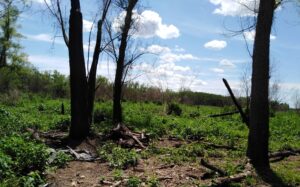
A few trees survived the fire near Fabián Ros’ home. (Photo: Paulo Rosas)
El escenario del fuego
El delta del Paraná ocupa un área mayor a 19.000 km2, repartida entre las provincias de Santa Fe, Buenos Aires y, mayoritariamente, Entre Ríos. En estas islas existe una enorme variedad de humedales, ecosistemas en los que habitan más de 700 especies de plantas y una diversidad de fauna que incluye más de 650 especies de animales, sin contar una enorme cantidad de invertebrados.
Así como Fabián, miles de personas habitan distintas zonas del delta del Paraná. La mayoría es de bajos ingresos económicos y se dedica a actividades como la pesca artesanal, la caza y la pequeña agricultura. Hay también quienes viven y trabajan como puesteros, una especie de cuidadores de las cabezas de ganado de empresarios.
Pero en 2020, esta realidad se vio afectada por los fuegos. Aunque estos no son totalmente ajenos a las islas. El guardaparques Rogelio Antúnez cuenta que siempre hubo quemas periódicas tradicionales, realizadas por ganaderos para renovar forraje durante el invierno. También advierte que hay fuegos accidentales, generados por descuidos de turistas o los mismos isleños. Lo normal siempre fue que estos fuegos encontraban su fin en los cortafuegos naturales: los brazos del río, los riachos y las lagunas. Sin embargo, este año nadie contó con una sequía histórica y una bajante del río sin precedentes en 50 años.
“Eso hizo que todos los cortafuegos se sequen, creando una continuidad de pastizales. Entonces, la gente quema como siempre, pero esa quema pequeña se convierte en un gran incendio forestal, trasladándose a lugares que nadie quema nunca”, explica Antúnez, quien ya ha peleado numerosas veces contra el fuego junto a brigadistas y los propios isleños.
“Cuando hay casas, la situación se complica y tenemos que ir a defenderlas. Hay lugares en los que el fuego se hace muy grande y se quema una casa, ahí buscamos salvar las otras”, se lamenta. Sin embargo, es optimista porque afirma que esta coyuntura ha acercado a su institución, la Administración de Parques Nacionales, a la población de las islas.
Y es que historias como las de Fabián se han repetido muchísimas veces este año, pero la inexactitud de las veces se debe a que no se sabe cuánta gente vive en las islas del delta. Es decir, no se sabe cuántas personas y familias recibieron ayuda, pelearon solas o sucumbieron ante las llamas.
Así, para Eduardo Spiaggi, doctor en agroecología e investigador de la Universidad Nacional de Rosario, los incendios “han puesto de manifiesto la desidia del Estado y la falta de políticas públicas hacia el sector”. Él y su equipo trabajan en el delta desde 2007, y es testigo del poco incentivo que propicia el Estado para que los isleños se queden. “El poblador local tendría que ser el primer garante del cuidado de ese ambiente, más que un guardaparques o un técnico. El trabajo conjunto necesario será muy difícil sin isleños”, estima.
En suma, hasta el 17 de octubre, de acuerdo a información del software Fire Information for Resource Management System (FIRMS) de la NASA, fueron detectados alrededor de 36,000 focos de calor en el delta del Paraná, cada foco de calor equivale a 375 m2. Para Natalia Morandeira, doctora en Ciencias Biológicas de la Universidad de Buenos Aires e investigadora experta en el delta, permite calcular el área afectada por el fuego: más de 350,000 hectáreas, equivalente a 3,500km2. De estos, el 84 por ciento de los fuegos se dieron en islas de Entre Ríos.
Morandeira coincide con Spiaggi en que los pobladores de las islas son las principales víctimas del fuego, sobre todo por estar “totalmente desprotegidos” por parte del Estado. “No hay acceso a la salud ni escuelas públicas. Creo que debería ser una de las prioridades en el futuro hacer un relevamiento de la población isleña, porque si no, terminarán dependiendo de las decisiones de quienes poseen la tenencia de la tierra”, remarca.
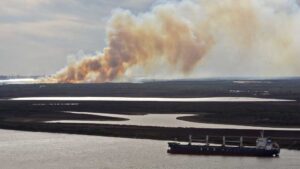
View of the smoke coming from the fires from the city of Rosario. (Photo courtesy of Télam)
Quemas con otros fines
En esa línea, la investigadora denunció que en unas islas de Entre Ríos, ubicadas frente a la ciudad bonaerense de Ramallo y que fueron quemadas en agosto, unos vecinos detectaron que el territorio empezó a ser fumigado y que actualmente está siendo usado para agricultura a gran escala, una actividad que en principio está prohibida en las islas y humedales del delta.
“Esto lo denunciamos el 16 de septiembre y hasta hoy no ha pasado nada. Mientras ven si los tenedores de la tierra están en regla o no, permiten que sigan avanzando con una agricultura intensiva con agroquímicos en humedales”, cuestiona.
Además del beneficio económico, habría un componente político. El presidente de Parques Nacionales, Daniel Somma, coincide con los diagnósticos previos de Morandeira y Spiaggi y, a partir de estos, plantea que “ya no se puede mantener una continuidad” con la manera en que se realizan las quemas tradicionales en el delta.
Sin embargo, Somma también habla de “una intencionalidad política en la reiteración de eventos de fuego frente a la ciudad de Rosario”. Él considera que las circunstancias en la que los fuegos aparecen no son azarosas y que, sumadas a la incertidumbre generada por la pandemia por la Covid-19, contribuyen a “generar malestar y una predisposición negativa” a causa del humo.
“Los fuegos ya no tienen que ver con manejo agropecuario. Es querer repetir el ‘efecto humo’ para afectar a la ciudad de Rosario. El sustento lógico puede ser generar malestar en la población de la segunda ciudad [más importante] del país”, acusa el funcionario.
El malestar de la ciudad
El 2 de agosto de 2020, el sitio web IQAir registró a Rosario como una de las ciudades con peor aire en el mundo. La ciudad santafesina, la más importante del territorio que alcanza el delta del Paraná, aparecía con un índice de calidad de aire de 152, catalogado como “dañino para la salud”. Todo esto, en medio de la pandemia causada por la Covid-19, un virus respiratorio.
Entre los meses de mayo y octubre, la población de Rosario se tuvo que acostumbrar al humo generado por las quemas. Si bien no era algo todos los días, podía ocurrir que un día la ciudad amaneciera asfixiada por el humo, con las consecuencias sanitarias que esto conlleva: irritación ocular y de garganta, así como problemas para respirar, dolor de cabeza, tos y fatiga.
Por estos motivos, distintas organizaciones civiles se organizaron para manifestarse en contra de las quemas en las islas. Una de las más importantes y que surgió en esta coyuntura específica fue la Multisectorial de Humedales. Cuenta su vocero Rodolfo Martínez que, el 11 de julio, alrededor de 150 personas se reunieron para protestar contra las quemas en el puente Rosario-Victoria. Al finalizar la manifestación, un grupo se reunió en asamblea y decidieron crear la Multisectorial. En ese momento, acordaron seguir manifestándose los siguientes fines de semana en el mismo lugar. El 8 de agosto, un mes después, habían convocado alrededor de 5,000 manifestantes, incluida gente de Victoria.
Ya constituidos, empezaron a desarrollar una serie de actividades, como formar equipos de voluntarios que ayuden a mitigar los incendios en las islas. Entre sus principales demandas, está la búsqueda de la aprobación de una ley que proteja los humedales del delta.
Finalmente, en lo que respecta a la justicia, un fiscal y un juez federal de Entre Ríos iniciaron una investigación sobre las quemas que buscará determinar si los dueños o tenedores de los territorios afectados propiciaron el fuego a sabiendas del impacto social, ecológico y sanitario. Al día de hoy, más de 50 personas, entre empresarios ganaderos y tenedores de tierras, han sido llamadas a declarar. De estos, conoce que hasta ahora solo siete están imputados por los presuntos delitos de “incendio u otro estrago y atentado contra la seguridad de naves y aeronaves”.
A casi tres meses del incendio, algunos árboles quemados permanecen en pie cerca de la casa de Fabián. El verde del terreno, sin embargo, ha reaparecido, así como los animales que habían sido expulsados por el fuego. Fabián sabe que la sequía continuará hasta el próximo año y será dura. También sabe que es inevitable que sigan apareciendo fuegos. “Seguro que hay intereses [detrás de los fuegos], pero es difícil hacer un juicio. Si el Estado estuviera presente, podríamos evitar esto y descubrir quiénes son los que están detrás de cada incendio”.
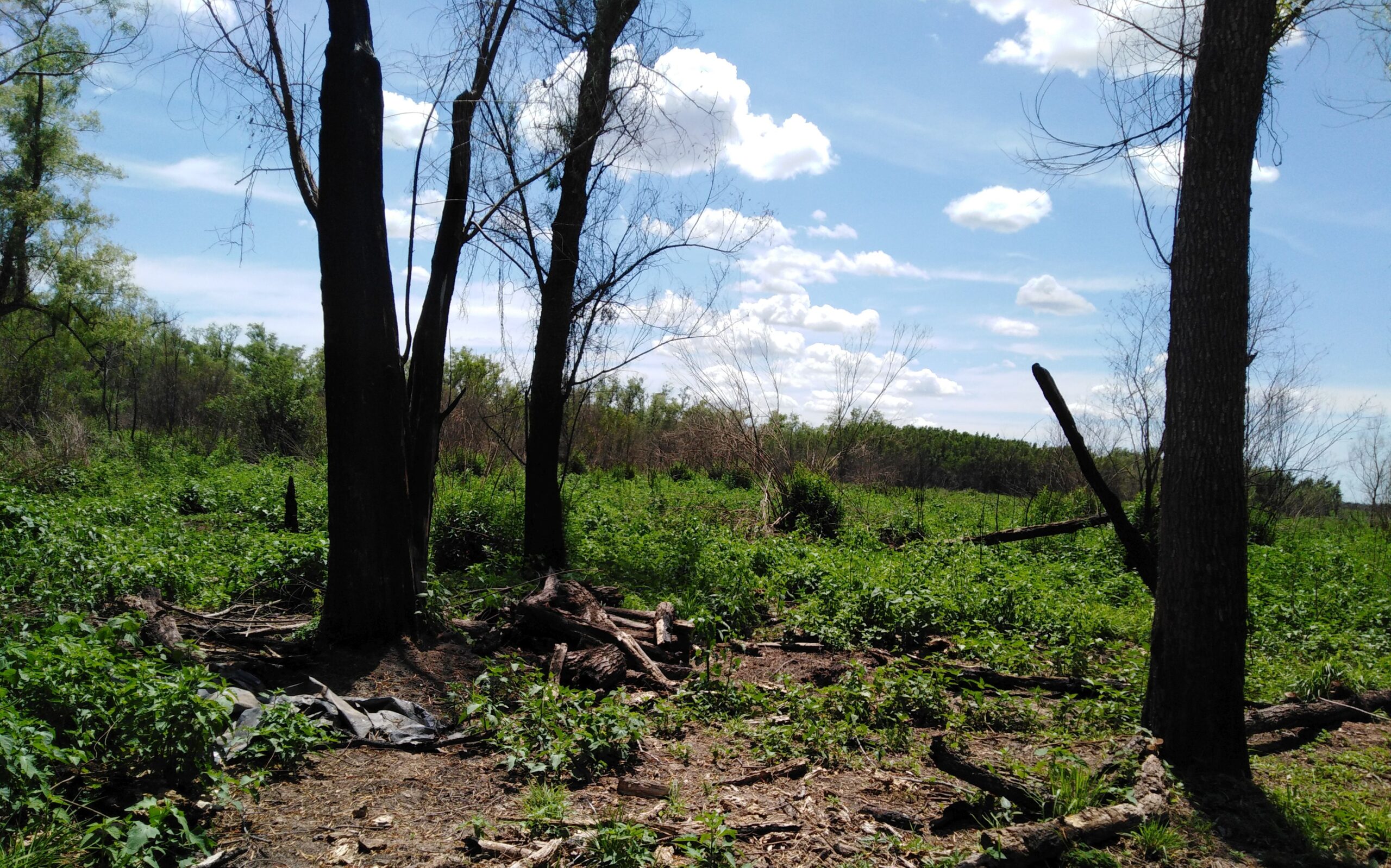
Fires in Argentina: Wildfires in the Paraná Delta Threaten Lives
Lee la historia en español aquí.
On Sunday, Aug. 23, around 3 p.m., a wildfire reached Fabián Ros’ house. Until that day, the 53-year-old and his wife, Viviana, had seen various fires and smoke columns several kilometers from their home, a cabin on the La Deseada island––one of the thousands that make up the Paraná river. But on that day, the fires finally reached their front door.
A lagoon located some 500 meters east of their cabin, dried up by the historic drought that hit the Paraná archipielago this year, served as a canal for the fires to advance. “The lagoon was a sea of straw and dried branches: it was dynamite,” Fabián recalled.
But Fabián and Viviana weren’t alone. Hours before, their sons––who live in Rosario, a city located right in front of their island––had warned them, their neighbors and volunteers of the approaching fire. Together, they began to improvise ways to stop the fire as it inched closer and closer.
As they struggled with the flames, three fire experts arrived––a neighbor and two brigade members from the National Fire Management Service. This calmed Fabián. Finally, he thought, people with a better strategy. They told the rest that they needed to fence the fire off. Stopping it was impossible, but they could divert it. They could put up a firewall that would prevent it from advancing toward the house.
The fire was coming from two flanks: one in the north and the other in the east. The flames from the north advanced faster. The plan was to cut the fire off, creating a ten-meter perimeter around the house and putting out the flames with whatever was on hand. They began. They used a lot of water but also saws and machetes to break up dry branches and logs that could have allowed the fire to advance. They succeeded. But after a few minutes, the fire met the eastern flank. “They collided, the treetops came alight. But it did not reach the house,” Fabián remembered.
Some ten meters away, people were spraying the house with hoses. From a window, Viviana threw buckets of water at the roof. They had to keep the house moist to prevent the leaves of the burning trees from reaching the house and burning everything. “At the most critical moment, one of the brigade members had to keep walking around the house, looking carefully to detect any sign of smoke.”
By 6 p.m., the worst had passed. The fire had surrounded the entire house, and the wind helped divert it in the opposite direction. It continued its course toward the highway that connects the cities of Rosario and Victoria. The worst three hours of Fabián’s life had passed.
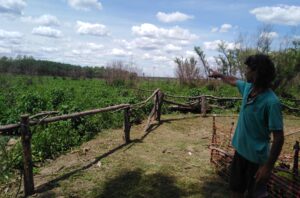
Fabián Ros points to the area scorched by the fire. Photo: Paulo Rosas
The scene of the fire
The Paraná delta occupies an area greater than 19,000 square kilometers, spread across the provinces of Santa Fe, Buenos Aires and Entre Ríos. These islands have a huge variety of wetlands, inhabited by more than 700 plant species and a diversity of fauna that includes more than 650 animal species, not counting a huge number of invertebrates.
Like Fabián, thousands live along the Paraná delta. Most neighbors are low-income workers who dedicate their lives to activities like artisanal fishing, hunting and small-scale farming. There are also some who live and work as stallholders, a kind of keeper who cares for local entrepreneurs’ cattle.
But, this year, their lives were affected by the fires like never before, although these fires are not totally foreign to the islands. Park ranger Rogelio Antúnez recalls that there have always been some periodic burning in the region, carried out by local farmers to renovate the pasture during the winter. He also recalls that there are sometimes some accidental fires, incidentally started by tourists or even the locals. Usually, these fires burn out once they meet the region’s natural firewalls: the rivers, the streams and the lagoons. However, no one expected there to be a historic drought this year that would lower the river’s water level to a degree not seen in 50 years.
“That caused all the firewalls to dry up, creating a continuity of grasslands. So, people kept burning as usual, but those small fires began to turn into huge forest fires, moving to places that no one ever burns,” said Antúnez, who has fought against fires many times along with brigade members and locals.
“When there are houses, the situation becomes more complicated, and we have to defend them. Sometimes the fires become too big and burn a whole house. In that case, we look to save the others,” he lamented. However, he is optimistic because he believes that this situation has brought his institution, the Administration of National Parks, closer to the people who live on the islands.
Though stories like Fabián’s have occurred on several occasions this year, the inaccuracy of just how many times is due to the fact that no one knows just how many people live on these islands. That is to say, it’s impossible to know how many people and families have received help, how many have fought alone, or how many have succumbed to the flames.
For Eduardo Spiaggi, a doctor in agroecology and researcher at the National University of Rosario, the fires “have revealed the neglect of the State and the lack of public policies directed toward the sector.” He and his team have worked in the delta since 2007, and he is witness to how little incentive the State provides for the islanders to stay and protect the region. “The local residents should be primarily responsible for the care of that environment, rather than a park ranger or a technician. The necessary joint work will be very difficult without the islanders’ input,” he estimated.
Up until Oct. 17, a total of around 36,000 heat sources were detected in the Paraná delta, according to data from NASA’s Fire Information for Resource Management System (FIRMS) software. Each heat source is equivalent to 375 m2. Natalia Morandeira, a doctor in biological sciences from the University of Buenos Aires and a researcher who specializes in studying the delta, has calculated the area affected by the fires to be over 350,000 hectares, or 3,500 km2. Out of this area, 84% of the fires were in the Entre Ríos islands.
Morandeira agrees with Spiaggi in that the local residents are the primary victims of the fires, above all because they are “totally unprotected” by the State. “There is no access to health services or public schools. I think that one of the priorities for the future should be to survey the islanders because, if not, they will end up depending on the decisions of those who own the land,” she said.

View of the smoke coming from the fires from the city of Rosario. (Photo courtesy of Télam)
A different kind of fire
To that end, Morandeira denounced that on one of the Entre Ríos islands, located in front of the Buenos Aires city of Ramallo and which burned in August, a neighbor noticed that the territory was being fumigated and that it is currently being used for large-scale agriculture, which is banned in the islands and wetlands of the delta.
“We denounced this on Sept. 16, and nothing has happened. While they wait to see if the land titles are in order or not, they are allowing them to continue with this large-scale agricultural project that intensely relies on the use of agrochemicals in these wetlands,” she said.
Beyond an economic benefit, there is also a political component. The president of the national parks, Daniel Somma, agrees with Morandeira and Spiaggi’s assessments and adds that “continuity can no longer be maintained” in the way in which traditional burning is carried out in the delta. “My perspective is that we have to organize ourselves in the use of fire in the delta through a system of planned prescribed burning,” he said.
Still, Somma also speaks of a “political motive in the repetition of fires in the city of Rosario.” He believes that the circumstances in which the fires start are not random and that, compounded by the uncertainty generated by the COVID-19 pandemic, they contribute to “generating discomfort and a negative predisposition” due to the smoke.
“The fires are no longer related to the agricultural management. They are driven by the desire to repeat the ‘smoke effect’ to affect the city of Rosario. The logical sustenance may be to generate unrest in the population of the second [most important] city in the country,” the official denounced.
The city’s unrest
On Aug. 2, the IQAir website listed Rosario as one of the cities with the worst air in the world. The Santa Fe city, the most important in the territory and which reaches the Paraná delta, registered an air quality index of 152, which is categorized as “harmful to one’s health.” All the while, this is all occurring in the midst of a pandemic caused by coronavirus, a respiratory virus.
Between May and October, the residents of Rosario had to get used to living with the smoke from the fires. Though the fires weren’t a daily occurrence, the city woke up and was asphyxiated by the smoke and the health consequences that that entails: eye and throat irritation, as well as breathing problems, headaches, cough and fatigue.
In response, various civil organizations planned a protest against the fires on the islands. One of the most important demonstrations was the Multisectorial de Humedales, a multisectorial protest against fires in the wetlands. Some 150 people joined the demonstration on Nov. 11 on the Rosario-Victoria bridge, according to the movement’s spokesperson Rodolfo Martínez. At the end of the protest, a group got together and decided to create the Multisectorial. At that moment, they agreed to continue protesting in the same place the following weekends. On Aug. 8, a month later, they managed to get 5,000 people to come out and protest, including people from Victoria.
From then on, they began to develop a series of activities, such as forming volunteer groups to help mitigate the fires on the islands. Among their primary demands is the approval of a law that protects the delta’s wetlands.
Finally, with regard to the justice system, a prosecutor and federal judge from Entre Ríos opened an investigation into the fires to determine where the owners or holders of the affected territories caused the fires, knowing their social, ecological and health impact. To date, more than 50 people, including cattle ranches and landowners, have been called forth to testify. Of these, seven have been charged with the alleged crimes of “arson or other damage and an attack against the safety of ships and aircrafts.”
Almost three months after the fire, some charred trees remain standing near Fabián’s house. The green of the terrain, however, has reappeared, as well as the animals that had been driven away by the fires. Fabián knows that the drought will continue until next year, and it will be difficult. He also knows that the fires are inevitable. “I’m sure there are interests [behind the fires], but it’s difficult to pass judgement. If the State were present, we could avoid this and find out who is behind each fire.”
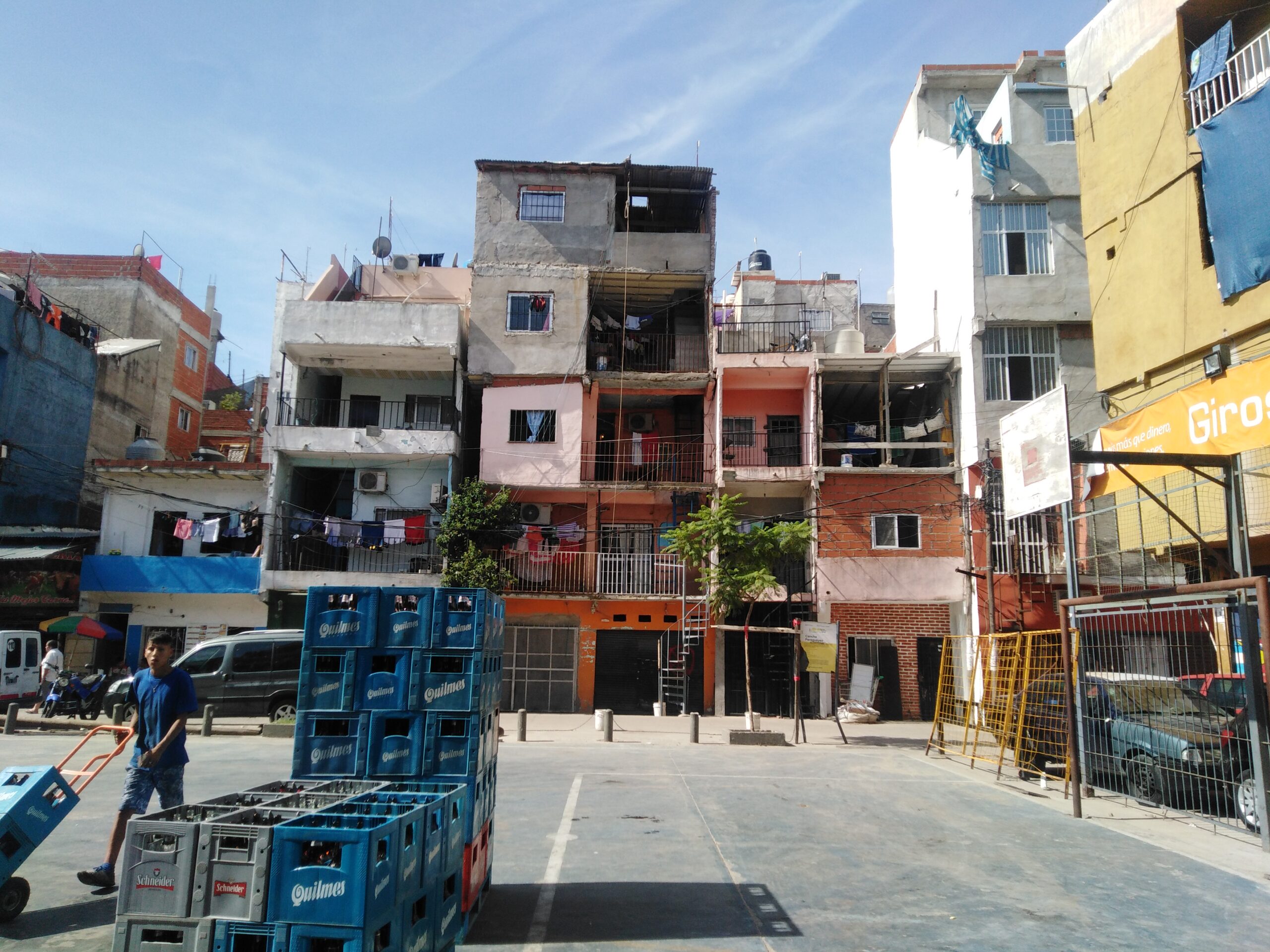
The Murder of a Peruvian Immigrant in Argentina Goes Unpunished
ROSARIO, Argentina—It all happened in a matter of seconds. There was a power outage and the street was dark. A man leapt out of a car and lunged at a woman. She struggled as he tried to take her wallet. She shouted for help. Luis Becerra Serna, 35, ran toward the scuffle. The thief took aim and fired. The bullet hit Luis in the right shoulder, and he fell to the ground. The thief got into a waiting car and fled.
Néstor Zimbaldo watched from the next street over. He ran to help the victim. When he got close, he realized the man was unconscious.
“I saw that he couldn’t breath well and that he was bleeding from the chest,” Zimbaldo remembers. “I started to move his body, to call his name, but he didn’t response. He was in agony.”
When an ambulance arrived minutes later, Luis, a Peruvian immigrant, was dead.
It was February 7, around 9pm, at the intersections of Cochabamba Street and Paraguay Street in Rosario, Argentina.
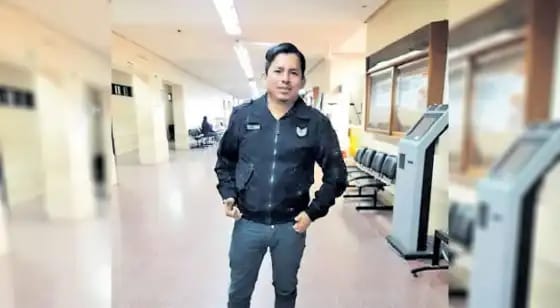
Luis Becerra, a Peruvian immigrant, was killed in Rosario, Argentina. Photo courtesy of Paulo Rosas Chávez.
Luis arrived in Argentina with his parents, David Becerra and Virginia Serna, in 2008. David and Virginia encouraged him to study, because higher education is free in Argentina. But Luis wanted to work. He quickly became a security guard and “cuidacoches,” watching parked cars for tips. He met a woman named Gabriela and they had a daughter together. Luis and Gabriela were saving to open a produce store together. The night of his murder, their plans came to an end.
Because Luis worked in the informal sector, he never paid into the pension system. His family will not receive compensation. Gabriela is seeking residency in Argentina so that she and her daughter can receive state support. In the meantime, she has no steady income. David and Virginia worry that the authorities will never solve their son’s murder.
Luis was one of thousands of Peruvians working in the margins in Argentina. Peruvian migration to Argentina has soared in the past decade. Peruvian immigrants face discrimination and struggle to establish themselves economically. Even those who hold advanced degrees often work as street vendors or in construction. Luis characterized the precarity that is the norm for many Peruvians in Argentina.
According to the last Argentine census, in 2010, 55.7 percent of Peruvians working in Argentina do not pay into social security, meaning they work in the informal economy. In 2010, there were just over 150,000 Peruvians living in Argentina.
Today the situation is even more complicated. The Peruvian Consulate in Buenos Aires reports that there are now 430,000 Peruvians in the country. More than 80 percent them live in the Buenos Aires metropolitan area.
Peruvian migration to Buenos Aires picked up speed in the 1990s. Peru was going through a deep social upheaval as the government fought the Shining Path guerrilla movement. An economic crisis and hyperinflation also afflicted the country. Thousands of Peruvians decided to seek a better future abroad. According to a recent book, Peruvians who did not have the means to migrate to countries like the United States and Japan set out for other Latin American countries like Argentina and Chile.
One of those early immigrants was Rocío Mazuelos. She arrived in Buenos Aires in 1991 from Huancayo, a city in the Peruvian mountains. She followed her husband who was already working in a Buenos Aires restaurant. But she didn’t anticipate the treatment she would receive in Argentina.
“Once I was in the subway with my husband,” she remembers, when they were still regularizing their migratory status. “A police officer stopped us and asked for our documents. He said we were illegal and pushed us up against the wall, like we were criminals. He started saying to the people walking by, ‘These are the people who rob you, look.’”
Rocío started working as a housekeeper and lived in the home of the family she worked for. On Sundays she could go see her husband, who slept at the restaurant where he worked. One Sunday, she met another Peruvian woman.
The women had paid a man to bring her to Buenos Aires and get her a job. But once they arrived in the capital, he left her at the bus station and disappeared. The woman wandered the city outskirts until an Argentine family took pity on her and took her in. The family was poor but didn’t mind that Rocío and other Peruvians started to gather on Sundays at their home, south of the Flores barrio of Buenos Aires.
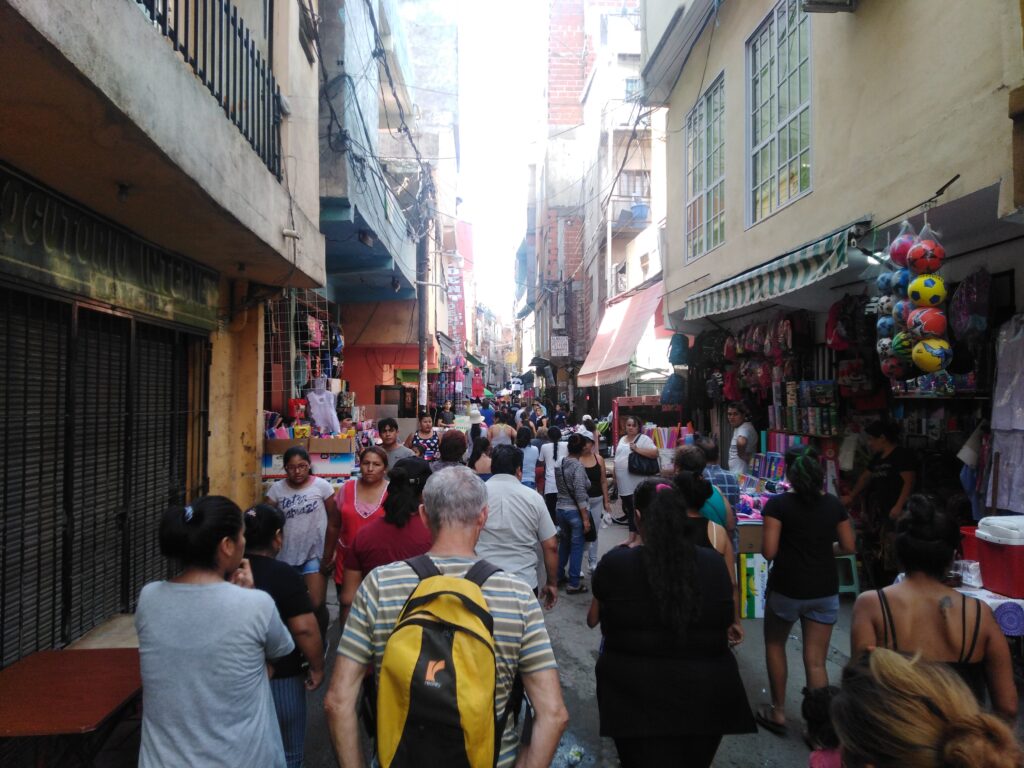
Barrio Padre Rodolfo Ricciardelli in Buenos Aires is home to many Peruvian, Bolivian and Paraguayan immigrants. Photo: Paulo Rosas Chávez.
As time went by, Bolivian and Paraguayan immigrants joined them in the neighborhood and started building homes with materials they found nearby. The area was designated Villa 1-11-14 and today is known as Barrio Padre Rodolfo Ricciardelli. Rocío was one of the first residents and today she is part of the neighborhood council. According to official statistics, more than 40,000 people live in Barrio Ricciardelli. Peruvians are the third largest group of immigrants, after Bolivians and Paraguayans.
Rocío says that the situation has changed for Peruvians in Argentina. Since 2003, legislation has made it easier to get residency and the government has worked to end institutional discrimination like what she experienced in the 1990s.
“But there is still discrimination in the street,” says Rocío. While it is easy for Peruvians to find work, few Peruvians work in the formal sector. She says that many Peruvian men work in construction and that women worked in the textile industry, sewing, and in the black market.
According to Carlos Vallejo, the General Consul for Peru in Buenos Aires, Peruvians who have moved to Argentina since 2002 do so for better opportunities for work, education and culture.
“The discrimination that Peruvians experience in the labor force is fueled by the social representations that depict Peruvians as unskilled laborers, only capable of holding less-valued jobs,” according to the International Organization for Migration (OIM).
While more Peruvians have entered administrative jobs, most still struggle to enter the formal workforce. The OIM attributes this to stereotypes and the barriers that Peruvians face to validate their degrees in Argentina.
“Many Peruvians with a university education end up working as street vendors because they cannot access other jobs,” writes the OIM. They note that this limits access to health care, retirement funds, bank loans and credit cards. In short, the situation that Luis’s family now faces.
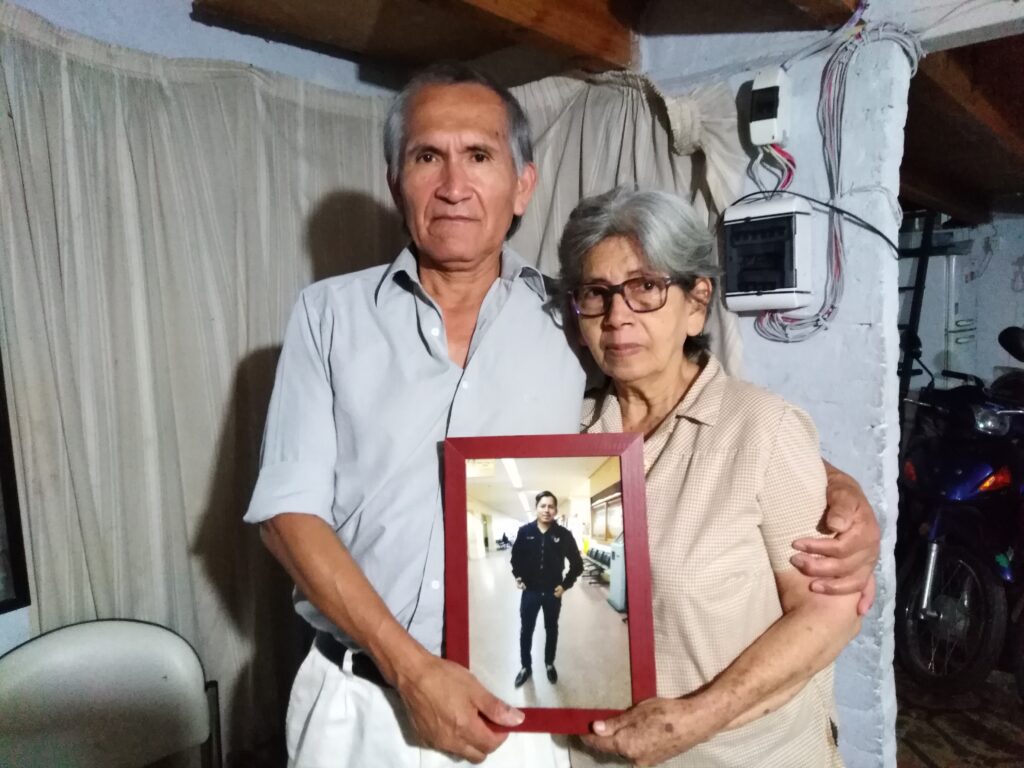
David Becerra and Virginia Serna hold a picture of their son Luis Becerra, murdered in February in Rosario, Argentina. Photo: Paulo Rosas.
Angélica Alvites Baiadera, a sociologist specialized in Peruvian migration in Argentina, says that Peruvians end up in the informal sector for several reasons.
“[Peruvians migrants] need jobs so they can send money back to their families,” Alvites says. “That’s why they accept these types of jobs, which are not only informal, but often have very long hours.”
They tend to work in sectors that already have a high percentage of informality, like domestic labor. Employers also take advantage of their irregular migratory status to not pay into social security. And because Peru has a high percentage of informal labor, Peruvians are more likely to accept these jobs in Argentina.
According to the National Institute of Statistics and Computing in Peru, 72 percent of the labor force is in the informal sector.
David Becerra is still surprised by the number of people, both Peruvians and Argentines, who came to his son’s wake and burial. Many people who met Luis in his work as a security guard came to say their final goodbye. Knowing the economic situation of his family, they were quick to offer material and economic aid.
To this day, people who knew Luis are helping Gabriela and his daughter. Even so, David worries that the investigation into his son’s murder will close without finding the culprit and his accomplices. He says that because Luis was a migrant, the authorities assume he was killed due to a criminal rivalry. David is committing to showing that was not the case. He insists that his son was not involved in crime. He was killed for trying to help someone else.
Prosecutor Adrián Spelta, a member of the Special Homicides Unit in Rosario, oversees the case. He says that the blackout that night has made it difficult to identify suspects. In an interview he said that none of the security cameras on the street captured the car that drove off. But he said they are working to get video recordings from cameras on nearby streets, and hopefully identify the vehicle. There is not a set timeline for the investigation.
Meanwhile, David and Virginia can only wait for justice to be served for the murder of their son.
“If there isn’t justice, Luis will keep asking for it, because souls demand justice,” says David. “I hope in his soul my son knows that I am doing everything I can.”
LAND thanks Fernando Manzano of CONICET for providing 2010 census data.